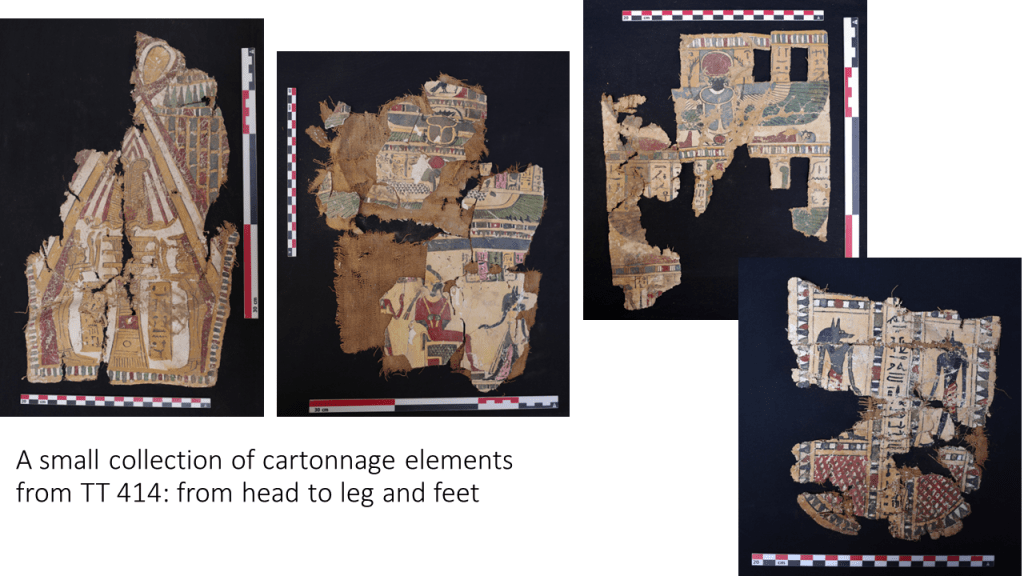It is well known that Ptolemaic mummies were typically equipped with trappings made of cartonnage. The most common cartonnage elements are a helmet-style funerary mask, a foot case and several panels along the body. Such elements are commonly displayed in museums and collections worldwide (and frequently found as objects sold on the art market). Several aspects like the manufacture process or stylistic features of such cartonnages have already been discussed by scholars, with a clear focus on funerary masks in Ptolemaic times (see e.g. Stadler 2004, Vandenbeusch et al. 2021).
In Theban funerary archaeology, little research has been done on Ptolemaic cartonnages. Such elements are mentioned frequently in excavation reports, but a concise assessment, including a study of the diachronic development in Ptolemaic times, still needs to be undertaken. Seminal, but only preliminary work was conducted by the late Gabor Schreiber (Schreiber 2006).
The rich corpus of cartonnage elements from TT 414 was also neglected and remains to be studied in detail and of course published. This material from the tomb of Ankh-Hor covers a long and intriguing period. Cartonnage trappings are already known from the in situ burial of Wahibre I (Bietak and Reiser-Haslauer 1982) and thus seem to start in the 30th Dynasty with a peak in early Ptolemaic times. In mid- to late Ptolemaic times cartonnage coffins replacing wooden coffins are attested from TT 414, allowing to compare the iconography of wooden coffins with that of cartonnage pieces.
During the current 2022 season of the LMU Ankh-Hor project, I managed to get a good overview of all the cartonnage elements from TT 414. It became obvious that there are many matching pieces throughout several boxes – it is a large jigsaw-puzzle very much comparable to the wooden coffin fragments. Many cartonnage elements belong to funerary masks, but also foot cases and trappings placed on the mummified body are well attested. Among my favourite elements are pectorals in the shape of broad collars. These usually show alternating dotted and floral motifs and include the representation of a winged scarab and falcon heads on the sides. Representations of the goddess Nut spreading her wings are also attested – thus a range of motifs also known from various types of coffins. In line with this, many of the cartonnage elements are decorated on both sides. Some cartonnage trappings also show actual scenes like the deceased being led by Anubis to Osiris (Fig. 1).

In addition to the stylistic assessment of the cartonnages from TT 414, much progress was done this season in identifying the owners of these trappings. Thanks to infrared photography, some names and titles became readable and allow to attribute cartonnage elements to Ptolemaic individuals already known from other objects.
One of my personal highlights is the identification of a new cartonnage element for Mr. Twt – an individual otherwise only attested by his outer anthropoid coffin in yellow-red on black-style (Fig. 2). Already in 2019, I was convinced that there must be other objects belonging to Twt – well, here we are, three years later with new evidence of cartonnage trappings.

These are just the first tentative steps into a very promising fields! Updates will follow, work continues!
References
Bietak, Manfred and Elfriede Reiser-Haslauer 1982. Das Grab des ‘Anch-Hor vol. II. Wien: Verlag der Österreichischen Akademie der Wissenschaften.
Schreiber, Gábor 2006. Ptolemaic cartonnages from Thebes. In Győry, Hedvig (ed.), Aegyptus et Pannonia III: Acta symposii anno 2004, 227-246. Budapest: MEBT-ÓEB.
Stadler, Martin Andreas 2004. Ägyptische Mumienmasken in Würzburg (Schenkung Gütte). Wiesbaden: Reicher.
Vandenbeusch, Marie, Daniel O’Flynn, and Benjamin Moreno 2021. Layer by layer: the manufacture of Graeco-Roman funerary masks. Journal of Egyptian Archaeology 107 (1-2), 281-298.
